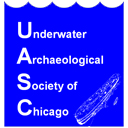Wednesday, April 28th @ 07:00 PM CST – Meeting of Underwater Archaeological Society of Chicago
Featured Presenter: Dr. Amanda Evans at 8:00 – Presenting: Great Lakes Shipwrecks and Submerged Paleolandscapes: Results from Central Lake Erie
Short Presentation by: Kendra Kennedy at 7:40 – Talking about her Background, Experience and Interests in Shipwreck Archaeology
Meeting time table:
Social: 06:30 – 07:00 PM CST,
Business Meeting: 07:00 – 07:40 PM CST,
Presentations: 07:40 – 09:00 PM CST (or later)
Meeting Registration link (NOTE: MUST REGISTER IN ADVANCE):
Meetings are open to the public, so feel free to invite anyone who you think would be interested.
We are switching to a registration system to make sure we have enough Zoom licenses so everyone can join. All you need to do is enter your name and email address. There are two other advantages, 1) You will have the option to enter the event in your electronic calendar and 2) Zoom will send you an email with the actually link to the meeting. This makes it easier to remember when the meeting is and where the link to the meeting is located.
Great Lakes Shipwrecks and Submerged Paleolandscapes: Results from Central Lake Erie
Ohio’s northern border represents over 300 miles of Lake Erie’s southern shoreline. The maritime history of this Great Lake is evident across the region, and estimates suggest there are anywhere between 1,400 and 8,000 shipwrecks in Lake Erie alone. While archaeologists have investigated Ohio shipwrecks in the past, these surveys have been concentrated in the western and central portions of the state. Between 2017 and 2020 archaeological work sponsored by the Ohio History Connection focused explicitly on eastern Ohio, and the waters off of Ashtabula County. Located on the border between Ohio and Pennsylvania, the harbors at Conneaut and Ashtabula were important industrial and commercial ports in the late nineteenth and early twentieth centuries. The project included a review of existing literature and archaeological data that informed the design of survey grids to investigate high probability areas for shipwreck sites and potential areas for submerged paleolandscape features. Geophysical survey was conducted in 2018 over eleven separate survey grids, resulting in the documentation of five wreck sites, some already known to divers, and others previously unexplored. Diver investigation in 2019 was conducted to groundtruth the remote sensing survey results and collect additional baseline data. The final report submitted to the Ohio History Connection included an assessment of the archaeological resources as well as recommendations for conducting future archaeological remote sensing survey in Ohio waters and preparing archaeological reports.
Biographies:
Dr. Amanda Evans is an underwater archaeologist with over twenty years of experience and currently serves as the Maritime Services Practice Leader for cultural heritage consulting firm Gray & Pape, Inc. She began studying archaeology and underwater science while at Indiana University and went on to earn an MA from Florida State University and a PhD from Louisiana State University. Dr. Evans’s specialties include underwater archaeology, with a concentration in submerged paleolandscapes and marine geophysics; shipwreck archaeology; physical site formation processes; and historic preservation and best practices regarding underwater cultural heritage. Her maritime project experience includes geophysical remote sensing, geotechnical sampling, remotely operated vehicle (ROV) survey, autonomous underwater vehicle (AUV) survey, and diver investigations. She has conducted and directed paleolandscape research in the Gulf of Mexico and Great Lakes, and has investigated shipwrecks including an eighteenth-century British naval sloop, nineteenth-century schooners, USS Hatteras, WWII casualties, and twentieth-century dredge barges, tugboats, and fishing vessels. Her project experience includes successful completion and documentation of all phases of archaeological projects in the Southeast, Midwest, Great Lakes, and Gulf coast regions of the United States, as well as the Bahamas, Belize, Dominican Republic, Cayman Islands, and the Mediterranean.
Kendra Kennedy has over 19 years of experience as an archaeologist, both maritime and terrestrial, in the Midwest, Mid-Atlantic, Southeast, and Gulf South. She is employed as a Cultural Resource Specialist with Argonne National Laboratory near Chicago. Ms. Kennedy has a B.A. in Anthropology and French from the University of Notre Dame and a M.A. in Historical Archaeology from the University of West Florida. She has previously worked as an archaeological consultant, SHPO reviewer, instructor, and grant writer for various organizations/agencies, including as a compliance reviewer and maritime archaeologist at the Ohio State Historic Preservation Office and a deepwater marine archaeologist for the oil and gas industry in Texas. She has worked on a sixteenth-century Spanish shipwreck, a possible War of 1812 gunboat, and several nineteenth- and twentieth-century shipwrecks in the Gulf of Mexico, Great Lakes, and inland rivers. Ms. Kennedy specializes in geophysical survey and interpretation and is passionate about public outreach and working with citizen scientists to advance the discipline. She currently serves as a board member of the Advisory Council on Underwater Archaeology and was previously on the board of the Ohio-based Maritime Archaeological Survey Team (MAST).
